ZHCSJF0 February 2019 ADC3244E
PRODUCTION DATA.
- 1 特性
- 2 应用
- 3 说明
- 4 修订历史记录
- 5 Device Comparison Table
- 6 Pin Configuration and Functions
-
7 Specifications
- 7.1 Absolute Maximum Ratings
- 7.2 ESD Ratings
- 7.3 Recommended Operating Conditions
- 7.4 Thermal Information
- 7.5 Electrical Characteristics: General
- 7.6 Electrical Characteristics: AC Performance
- 7.7 Digital Characteristics
- 7.8 Timing Requirements: General
- 7.9 Timing Requirements: LVDS Output
- 7.10 Typical Characteristics
- 7.11 Typical Characteristics: Contour
- 8 Parameter Measurement Information
-
9 Detailed Description
- 9.1 Overview
- 9.2 Functional Block Diagram
- 9.3 Feature Description
- 9.4 Device Functional Modes
- 9.5 Programming
- 9.6
Register Maps
- 9.6.1 Summary of Special Mode Registers
- 9.6.2
Serial Register Description
- 9.6.2.1 Register 01h
- 9.6.2.2 Register 03h
- 9.6.2.3 Register 04h
- 9.6.2.4 Register 05h
- 9.6.2.5 Register 06h
- 9.6.2.6 Register 07h
- 9.6.2.7 Register 09h
- 9.6.2.8 Register 0Ah
- 9.6.2.9 Register 0Bh
- 9.6.2.10 Register 0Eh
- 9.6.2.11 Register 0Fh
- 9.6.2.12 Register 13h (address = 13h)
- 9.6.2.13 Register 15h
- 9.6.2.14 Register 25h
- 9.6.2.15 Register 27h
- 9.6.2.16 Register 41Dh
- 9.6.2.17 Register 422h
- 9.6.2.18 Register 434h
- 9.6.2.19 Register 439h
- 9.6.2.20 Register 51Dh
- 9.6.2.21 Register 522h
- 9.6.2.22 Register 534h
- 9.6.2.23 Register 539h
- 9.6.2.24 Register 608h
- 9.6.2.25 Register 70Ah
- 10Applications and Implementation
- 11Power Supply Recommendations
- 12Layout
- 13器件和文档支持
- 14机械、封装和可订购信息
9.3.2 Clock Input
The device clock inputs can be driven differentially (sine, LVPECL, or LVDS) or single-ended (LVCMOS), with little or no difference in performance between them. The common-mode voltage of the clock inputs is set to
0.95 V using internal 5-kΩ resistors. The self-bias clock inputs of the ADC3244E are driven by the transformer-coupled, sine-wave clock source or by the ac-coupled, LVPECL and LVDS clock sources, as shown in Figure 43, Figure 44, and Figure 45. See Figure 46 for details regarding the internal clock buffer.
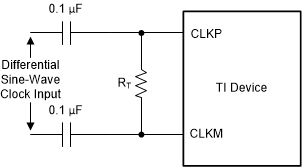
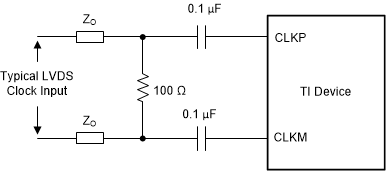 Figure 44. LVDS Clock Driving Circuit
Figure 44. LVDS Clock Driving Circuit 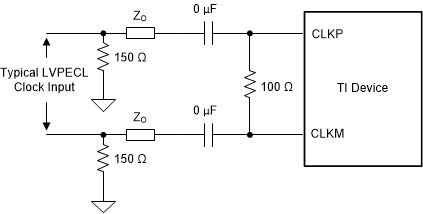 Figure 45. LVPECL Clock Driving Circuit
Figure 45. LVPECL Clock Driving Circuit 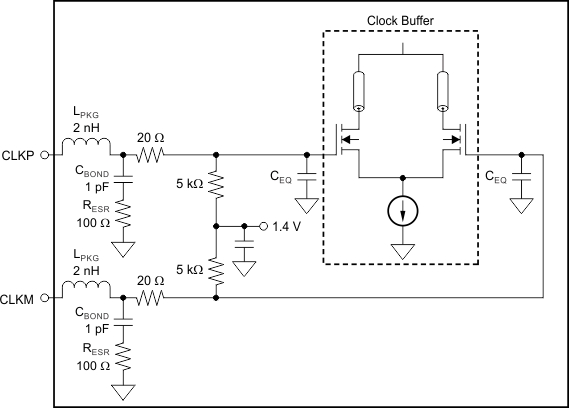
A single-ended CMOS clock can be ac-coupled to the CLKP input, with CLKM connected to ground with a 0.1-μF capacitor, as shown in Figure 47. However, for best performance the clock inputs must be driven differentially, thereby reducing susceptibility to common-mode noise. For high input frequency sampling, TI recommends using a clock source with very low jitter. Band-pass filtering of the clock source can help reduce the effects of jitter. There is no change in performance with a non-50% duty cycle clock input.
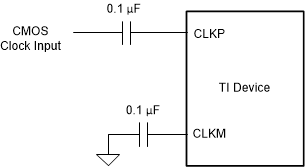 Figure 47. Single-Ended Clock Driving Circuit
Figure 47. Single-Ended Clock Driving Circuit